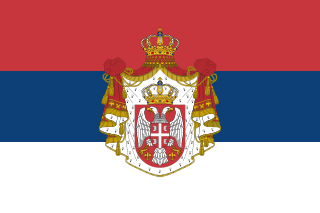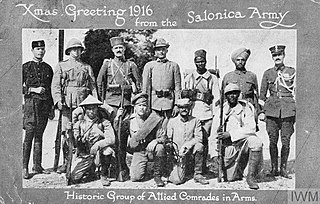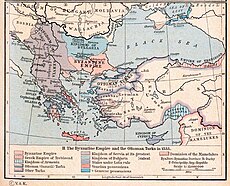
The Balkan Wars were a series of two conflicts that took place in the Balkan states in 1912 and 1913. In the First Balkan War, the four Balkan states of Greece, Serbia, Montenegro and Bulgaria declared war upon the Ottoman Empire and defeated it, in the process stripping the Ottomans of their European provinces, leaving only Eastern Thrace under the Ottoman Empire's control. In the Second Balkan War, Bulgaria fought against the other four original combatants of the first war. It also faced an attack from Romania from the north. The Ottoman Empire lost the bulk of its territory in Europe. Although not involved as a combatant, Austria-Hungary became relatively weaker as a much enlarged Serbia pushed for union of the South Slavic peoples. The war set the stage for the July crisis of 1914 and thus served as a prelude to the First World War.

The League of the Balkans was a quadruple alliance formed by a series of bilateral treaties concluded in 1912 between the Eastern Orthodox kingdoms of Greece, Bulgaria, Serbia and Montenegro, and directed against the Ottoman Empire, which at the time still controlled much of Southeastern Europe.

The region of Macedonia is known to have been inhabited since Paleolithic times.

The Internal Macedonian Revolutionary Organization, was a secret revolutionary society founded in the Ottoman territories in Europe, that operated in the late 19th and early 20th centuries.

The Kingdom of Serbia was a country located in the Balkans which was created when the ruler of the Principality of Serbia, Milan I, was proclaimed king in 1882. Since 1817, the Principality was ruled by the Obrenović dynasty. The Principality, under the suzerainty of the Ottoman Empire, de facto achieved full independence when the very last Ottoman troops left Belgrade in 1867. The Congress of Berlin in 1878 recognized the formal independence of the Principality of Serbia, and in its composition Nišava, Pirot, Toplica and Vranje districts entered the South part of Serbia.

The Balkans theatre or Balkan campaign was a theatre of World War I fought between the Central Powers and the Allies.

The Serbian campaign was a series of military expeditions launched in 1914 and 1915 by the Central Powers against the Kingdom of Serbia during the First World War.

The Macedonian front, also known as the Salonica front, was a military theatre of World War I formed as a result of an attempt by the Allied Powers to aid Serbia, in the autumn of 1915, against the combined attack of Germany, Austria-Hungary and Bulgaria. The expedition came too late and with insufficient force to prevent the fall of Serbia and was complicated by the internal political crisis in Greece. Eventually, a stable front was established, running from the Albanian Adriatic coast to the Struma River, pitting a multinational Allied force against the Bulgarian army, which was at various times bolstered with smaller units from the other Central Powers. The Macedonian front remained stable, despite local actions, until the Allied offensive in September 1918 resulted in Bulgaria capitulating and the liberation of Serbia.

The Kosovo offensive of 1915 was a World War I offensive launched as part of the Serbian campaign of 1915. It involved the Central Powers and the Kingdom of Serbia.

The Kingdom of Bulgaria participated in World War I on the side of the Central Powers from 14 October 1915, when the country declared war on Serbia, until 30 September 1918, when the Armistice of Salonica came into effect.

The history of Macedonians has been shaped by population shifts and political developments in the southern Balkans, especially within the region of Macedonia. The ideas of separate Macedonian identity grew in significance after the First World War, both in Vardar and among the left-leaning diaspora in Bulgaria, and were endorsed by the Comintern. During the Second World War, these ideas were supported by the Communist Partisans, but the decisive point in the ethnogenesis of these South Slavic people was the creation of the Socialist Republic of Macedonia after World War II, as a new state in the framework of the Socialist Federal Republic of Yugoslavia.

The Austro-Hungarian Armed Forces occupied Serbia from late 1915 until the end of World War I. Austria-Hungary's declaration of war against Serbia on 28 July 1914 marked the beginning of the war. After three unsuccessful Austro-Hungarian offensives between August and December 1914, a combined Austro-Hungarian and German offensive breached the Serbian front from the north and west in October 1915, while Bulgaria attacked from the east. By January 1916, all of Serbia had been occupied by the Central Powers.

The Great Retreat, also known in Serbian historiography as the Albanian Golgotha, refers to the retreat of the Royal Serbian Army through the mountains of Albania during the 1915–16 winter of World War I.
The Toplica Uprising was a mass uprising against Bulgarian occupation force that took place in Bulgarian occupied Serbia during the First World War. The rebels were motivated by grievances against the Bulgarian authorities for ordering conscription of local Serbs in the Bulgarian army, forced labour and the denationalization policy imposed on the indigenous population. The revolt was supported by Serbian guerrilla fighters known as Chetniks.

The Surdulica massacre was the mass murder of Serbian men by Bulgarian occupational authorities in the southern Serbian town of Surdulica in 1916 and early 1917, during World War I. Members of the Serbian intelligentsia in the region, mostly functionaries, teachers, priests and former soldiers, were detained by Bulgarian forces—ostensibly so that they could be deported to the Bulgarian capital, Sofia—before being taken into the forests around Surdulica and killed. An estimated 2,000–4,000 Serbian men were executed by the Bulgarians in the town and its surroundings. Witnesses to the massacre were interviewed by American writer William A. Drayton in December 1918 and January 1919.
Chetniks in World War I were members of auxiliary units used by the Royal Serbian Army for special operations against invading Austro-Hungarian, Bulgarian and German forces.

The Štip massacre was the mass murder of Serbian soldiers by paramilitary forces of the Internal Macedonian Revolutionary Organization (IMRO) in the village of Ljuboten, Štip on 15 October 1915, during World War I. Sick and wounded Serbian soldiers, recuperating at the Štip town hospital, were detained by Macedonian IMRO militants before being taken into the vicinity of Ljuboten and killed. An estimated 118–120 Serbian soldiers were executed in the massacre.
Sliven was a prisoner-of-war camp established in Sliven in 1915 with the intent of housing Serbian troops captured during the course of World War I. Over time Greek and Serbian civilians joined their ranks reaching 19,000 at its peak. From 1916 until its dissolution in 1918, the camp served as a punitive institution. Internees suffered from the lack of proper housing conditions, typhus, malnutrition and ill treatment from their guards. This led to the deaths of over 6,000 prisoners.

The Serbian campaign of 1915 refers to a military campaign carried out by the Central Powers, primarily Germany, Austria-Hungary and Bulgaria, against the Kingdom of Serbia during World War I. The campaign took place from October to November 1915.

The Military General Governorate of Serbia was a military administration established by the Austro-Hungarian Army during the Austro-Hungarian occupation of Serbia. The Governorate existed from 1 January 1916 to 1 November 1918 during World War I. Along with Bulgarian occupied Serbia, it was one of the two separate occupation zones created after the Kingdom of Serbia was invaded and partitioned by the Central Powers.

























